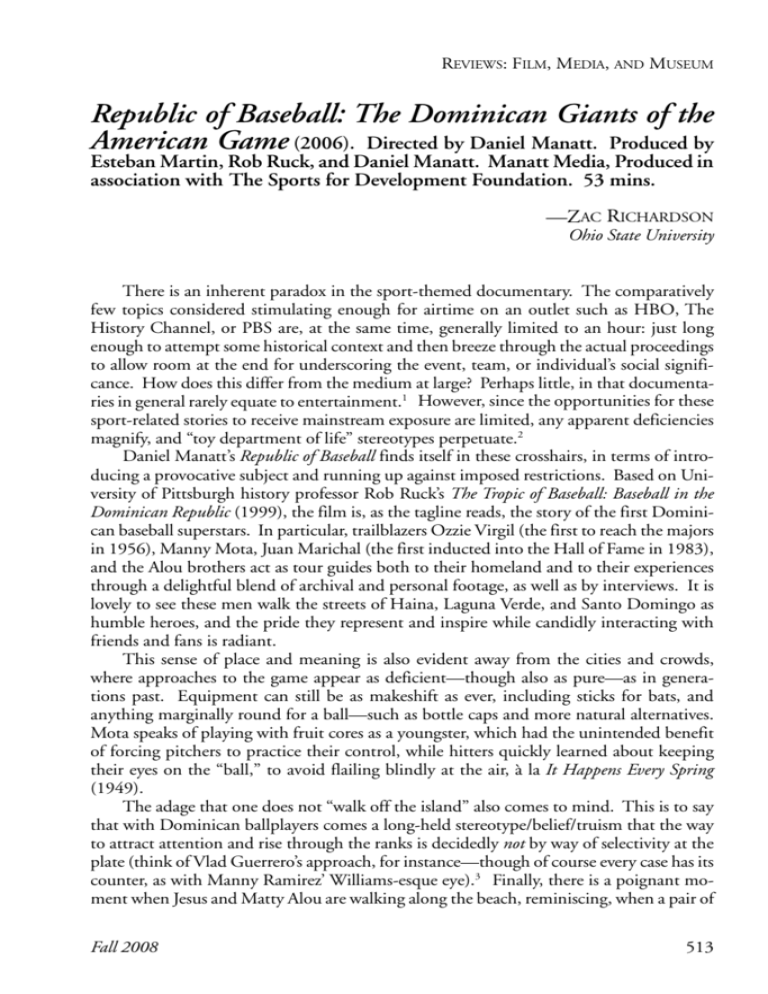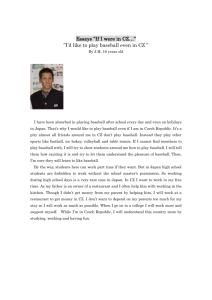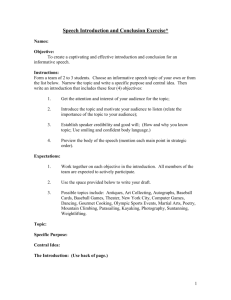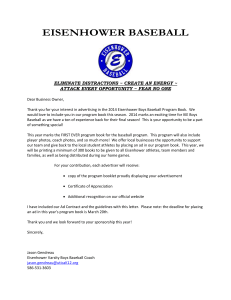Republic of Baseball: The Dominican Giants of the American Game
advertisement

REVIEWS: FILM, MEDIA, AND MUSEUM Republic of Baseball: The Dominican Giants of the American Game (2006). Directed by Daniel Manatt. Produced by Esteban Martin, Rob Ruck, and Daniel Manatt. Manatt Media, Produced in association with The Sports for Development Foundation. 53 mins. —ZAC RICHARDSON Ohio State University There is an inherent paradox in the sport-themed documentary. The comparatively few topics considered stimulating enough for airtime on an outlet such as HBO, The History Channel, or PBS are, at the same time, generally limited to an hour: just long enough to attempt some historical context and then breeze through the actual proceedings to allow room at the end for underscoring the event, team, or individual’s social significance. How does this differ from the medium at large? Perhaps little, in that documentaries in general rarely equate to entertainment.1 However, since the opportunities for these sport-related stories to receive mainstream exposure are limited, any apparent deficiencies magnify, and “toy department of life” stereotypes perpetuate.2 Daniel Manatt’s Republic of Baseball finds itself in these crosshairs, in terms of introducing a provocative subject and running up against imposed restrictions. Based on University of Pittsburgh history professor Rob Ruck’s The Tropic of Baseball: Baseball in the Dominican Republic (1999), the film is, as the tagline reads, the story of the first Dominican baseball superstars. In particular, trailblazers Ozzie Virgil (the first to reach the majors in 1956), Manny Mota, Juan Marichal (the first inducted into the Hall of Fame in 1983), and the Alou brothers act as tour guides both to their homeland and to their experiences through a delightful blend of archival and personal footage, as well as by interviews. It is lovely to see these men walk the streets of Haina, Laguna Verde, and Santo Domingo as humble heroes, and the pride they represent and inspire while candidly interacting with friends and fans is radiant. This sense of place and meaning is also evident away from the cities and crowds, where approaches to the game appear as deficient—though also as pure—as in generations past. Equipment can still be as makeshift as ever, including sticks for bats, and anything marginally round for a ball—such as bottle caps and more natural alternatives. Mota speaks of playing with fruit cores as a youngster, which had the unintended benefit of forcing pitchers to practice their control, while hitters quickly learned about keeping their eyes on the “ball,” to avoid flailing blindly at the air, à la It Happens Every Spring (1949). The adage that one does not “walk off the island” also comes to mind. This is to say that with Dominican ballplayers comes a long-held stereotype/belief/truism that the way to attract attention and rise through the ranks is decidedly not by way of selectivity at the plate (think of Vlad Guerrero’s approach, for instance—though of course every case has its counter, as with Manny Ramirez’ Williams-esque eye).3 Finally, there is a poignant moment when Jesus and Matty Alou are walking along the beach, reminiscing, when a pair of Fall 2008 513 JOURNAL OF SPORT HISTORY boys jogs past them in the opposite direction. The untrained eye would simply see this as youngsters at play. Jesus and Matty, however, look at each other knowingly, and laugh— noting that the boys are probably in fact training for their baseball season, in yet another demonstration of the lifeblood that is baseball to the Dominicans, embracing and excelling at the game they love through whatever means are available, rather than succumbing to apparent limitations. Though the film essentially spans the twentieth century, with numerous focal points and plot twists in a largely historical-chronological approach, Republic of Baseball is primarily the story of Felipe Alou. Just as a legacy of Ken Burns’s Baseball documentary series is commonly personified in Buck O’Neil’s perspectives of the sport and its conflicted social history, many of the most vivid impressions Manatt frames have the eldest Alou brother as their narrator and at their center. Of course, no one would ever confuse the warmly charismatic O’Neil with Alou’s stoic pride. However, as a fellow baseball-lifer and cultural-barrier-straddler, Alou’s story and storytelling are similarly valuable and compelling— and this, in turn, is every bit the asset to Manatt’s documentary as O’Neil was to Burns’s. Much of this Alou material will be familiar to readers of Bruce Adelson’s Brushing Back Jim Crow: The Integration of Minor-League Baseball in the American South (1999).4 Regardless, hearing and watching his recollections is stirring, in a way that even the best transcription is simply unable to capture or recreate. For example, Alou’s memories of watching Jackie Robinson play an exhibition game in Santo Domingo—and the sense of possibility this gave him and his baseball-loving compatriots—is priceless. Also leaving a deep impression is Alou’s confusion and shock at the realities faced as a minor leaguer in the American South of the 1950s, based on having grown up in a dictatorship and the visions Dominicans thus held of the United States as a beacon of democracy. It is particularly moving to learn of his growth through these experiences. Alou, initially unable to speak or understand English (though he was certainly aware of the attitudes his presence frequently inspired), ultimately drew from a previously untapped and unknown well of rebellion, blatantly ignoring Jim Crow regulations at restaurants, hotels, and elsewhere in acts of leadership and courage that inspired fellow minorities and won over many white teammates alike. Near the end of the film, broadcaster Jon Miller introduces Felipe to the 2003 Opening Day crowd as the new manager—and as the only man to appear in a Giants uniform at Seals Stadium, Candlestick Park, and (then) Pacific Bell Park. With this, Alou’s story comes full-circle, returning to the team with which he began his career, and from which he was traded forty years earlier, following a World Series appearance in 1962. It also shows his continued activism on behalf of baseball players in general and Latinos in particular (to the displeasure of the Giants’ and Major League Baseball’s hierarchy). It must be said, however, that this reveals some of Republic of Baseball’s unevenness, or (time) limitations, as well. Manatt gives considerable focus to these Giants teams of the early 1960s—justifiably so for their success and exciting brand of baseball, with a decidedly Latino flair. At the same time, the film rather abruptly changes tone from something generally introspective and contemplative—a social study—to more of a traditional highlight-reel approach. Perhaps this is the best or only way to insert this material, and it is undeniably worthwhile and important to the story. Marichal’s promotion to the team in 1960 added considerable character and talent, Matty Alou soon followed, and the “Gigantes” 514 Volume 35, Number 3 REVIEWS: FILM, MEDIA, AND MUSEUM became a national obsession for the Dominican Republic. The film would benefit from transitioning into and out of this section of the film with greater nuance, however, to avoid the resultant episodic and forced feeling—which could very easily be a byproduct of time constraints. Another opportunity for more fully realized contextualization is suggested at the beginning of the documentary, where contemporary Dominican players such as Guerrero, Pedro Martinez, and Alfonso Soriano briefly touch on the significance of their baseballforefathers. The film does not reconnect with these voices, however—literally or figuratively—and, in fact, essentially moves from the final days of the Dominican Giants experience in San Francisco to the Felipe Alou-themed conclusion, which ultimately feels rather rushed. Lastly, it cannot be overlooked that one of Republic’s first scenes is of Miguel Tejada in action. When the film completed production in 2006, this was not the issue it is now—when Tejada represents the murky waters of birth certificate manipulation and is also dogged by steroid suspicions (and possible litigation). Sammy Sosa is conspicuously unnamed and unseen throughout the film, presumably with the intent of sidestepping similar issues—but this avoidance is somewhat counterproductive and self-conscious, in the same way that Marichal’s bat-wielding episode against the Dodgers’ Johnny Roseboro receives only the briefest of mentions. These limitations do require consideration, though none overshadow or undercut the value of Republic of Baseball. The DVD case claims to provide a history previously overlooked, and the viewing offers this in an entertaining and academically worthwhile format for scholars and fans alike. In terms of classroom use, the film is perhaps best utilized for introductory purposes or to complement/round out a section on matters of race in the mid twentieth-century American sporting world. For deeper exploration of these issues, however, it would probably work better as a means of bringing to life its source material, Ruck’s Tropic of Baseball.5 1 In his October 21, 1994, review of the Steve James-directed Hoop Dreams, Roger Ebert notes, “[M]any filmgoers are reluctant to see documentaries, for reasons I’ve never understood; the good ones are frequently more absorbing and entertaining than fiction,” <http://rogerebert.suntimes.com/apps/ pbcs.dll/article?AID=/19941021/REVIEWS/410210301> [23 May 2008]. 2 Attributed to Howard Cosell by Wayne Wanta, in “The Coverage of Sports in Print Media,” Handbook of Sports in Media, eds. Arthur A. Raney and Jennings Bryant (Mahwah, N.J.: Routledge, 2006), 105. 3 There are many versions of and attributions to this quotation, as confirmed by a recent Society for American Baseball Research (SABR) listserv discussion on the topic. Rafael Ramirez is quoted in 1987 as saying, “You have to swing like a man. A walk won’t get you off the island,” in David H. Nathan’s Baseball Quotations: The Wisdom and Wisecracks of Players, Managers, Owners, Umpires, Announcers, Writers and Fans of the Great American Pastime (Jefferson, N.C.: McFarland, 1991), 58. Additionally, in a personal email, Bill Deane recounts the following from a Baseball Digest article he wrote after the 2000 season: “There used to be a baseball saying, ‘You can’t walk off an island.’ It referred to the observation that most Latin-born players were free swingers, rarely taking a base on balls. They had been taught early on that the only way to attract the attention of major league scouts was by their hitting ability, not their patience; so, their only hope to leave their native islands for the promised land of the majors was to go up there hacking. The facts support this observation: out of thousands of player-seasons prior to 1999, only one Latin-born player—Danny Tartabull (Dominican Republic), who had 103 for the Yankees in 1992— had drawn 100 walks in a season” (Bill Deane, “Walking off an Island,” Baseball Digest, 10 May 2008). Fall 2008 515 JOURNAL OF SPORT HISTORY 4 Bruce Adelson, Brushing Back Jim Crow: The Integration of Minor-League Baseball in the American South (Charlottesville: University Press of Virginia, 1999). With regard to his firsthand accounts/interviews, Adelson’s sourcing is somewhat vague. This is partly due to an intermingling of secondary sources, resulting in a presentation that is in essentially the same form as the author’s actual conversations, giving the impression that these recollections all occurred around the same period, and/or were primary sources, and/or were firsthand conversations. Additionally, the nature and methodology of the interviews is not specified (and nowhere clearly indexed), leaving a void in terms of how accurate the reflections may be, or how the conversations may have been conducted. Thus, though they have their similarities (and while the book also utilizes an impressive array of newspaper sources), Alou’s recollections in Manatt’s film must be considered more reliable than those in Adelson’s book. 5 In fairness to Adelson, while Tropic of Baseball is very well indexed and the product of extensive translated interviews, it too lacks the citations customary to historical works. 516 Volume 35, Number 3





